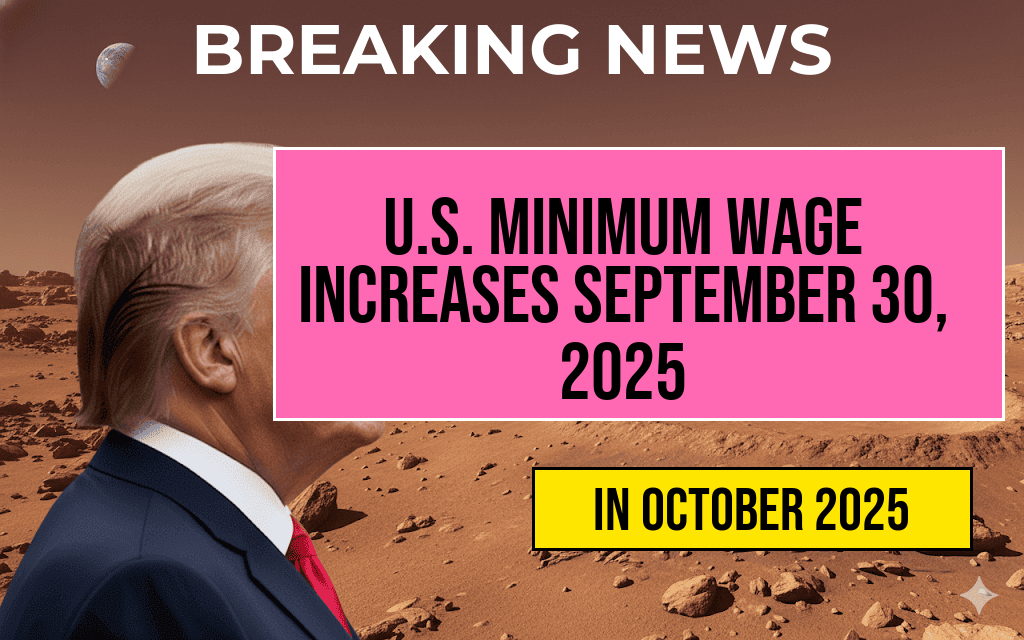The U.S. minimum wage is poised for an increase on September 30, 2025, marking a significant step in federal labor policy aimed at improving the living standards of millions of American workers. As part of this adjustment, the federal minimum wage will rise to $15.00 per hour, up from the current rate of $7.25 per hour. This decision comes amid ongoing debates about wage disparities and the cost of living across the United States. Ahead of this change, a comprehensive hourly wage list has been released, detailing how the new minimum wage will impact various sectors and states. This adjustment is expected to influence not only workers but also businesses, as they prepare for the economic implications of higher labor costs.
Context of the Minimum Wage Increase
The push for a higher minimum wage has gained traction in recent years, driven by rising inflation and increasing living costs. Advocates argue that a $15.00 hourly wage is essential for low-income families to afford basic necessities such as housing, healthcare, and education. The increase is anticipated to benefit not just workers in low-paying jobs, but also stimulate local economies as more people have disposable income to spend.
Details of the Minimum Wage Increase
The federal minimum wage has not been adjusted since 2009, making this upcoming change particularly significant. The decision to increase the wage is part of a broader legislative effort to address economic inequality and support the workforce. The new wage will be implemented in a phased approach, allowing businesses time to adapt to the new economic landscape.
Comprehensive Hourly Wage List
The following table outlines the new minimum wage across various sectors, illustrating the anticipated impacts on different industries:
| Sector | Current Minimum Wage | New Minimum Wage (Effective September 30, 2025) |
|---|---|---|
| Retail | $7.25 | $15.00 |
| Food Service | $2.13 (tipped) | $15.00 (non-tipped)/$10.00 (tipped) |
| Healthcare | $12.00 | $15.00 |
| Construction | $10.00 | $15.00 |
| Manufacturing | $11.00 | $15.00 |
Potential Impact on Businesses
Businesses across the country are preparing for the financial implications of this wage increase. Many small and medium-sized enterprises express concern about how to manage the additional labor costs while remaining competitive. Some industry leaders advocate for a gradual increase rather than a sudden jump to $15.00 per hour, arguing that it could lead to job losses or increased prices for consumers.
According to a report by the Forbes Human Resources Council, a higher minimum wage could encourage employers to invest in technology and automation to offset increased labor costs. This shift may change the job landscape, as businesses seek more efficient ways to operate.
State-Level Variations
While the federal minimum wage will rise to $15.00, many states and cities have already implemented higher minimum wages. For instance, states like California and New York have set their minimum wages at $15.00 or more, with plans for further increases in the coming years. This state-level variation emphasizes the growing trend towards localized wage adjustments based on the cost of living.
Conclusion
The upcoming increase in the federal minimum wage to $15.00 per hour on September 30, 2025, represents a critical moment in the ongoing conversation about fair wages in the United States. As the country prepares for this change, the effects will reverberate throughout the economy, influencing not only workers but also businesses and consumers alike. Stakeholders across all sectors will need to navigate this transition thoughtfully to ensure that the goals of fair compensation and economic stability are met.
Frequently Asked Questions
What is the new U.S. minimum wage set to be on September 30, 2025?
The new U.S. minimum wage will rise to $15.00 per hour on September 30, 2025, reflecting an increase aimed at improving the living standards for workers.
Why is the minimum wage increasing in 2025?
The increase in the minimum wage is part of a broader initiative to address inflation and ensure that workers can meet their basic needs amidst rising costs of living.
Where can I find the comprehensive hourly wage list?
A comprehensive hourly wage list detailing various wage rates across different states and industries will be made available through government resources and labor websites.
Will all states adopt the new federal minimum wage?
While the new federal minimum wage will apply nationwide, some states may choose to maintain a higher minimum wage, so it’s essential to check local regulations.
How will the minimum wage increase affect employers?
The rise in minimum wage may lead to increased labor costs for employers, prompting some to adjust their business models, raise prices, or seek efficiencies to accommodate the change.

Leave a Reply